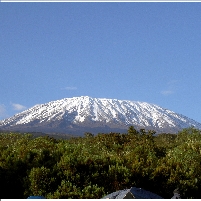Snows of Kilimanjaro Are Melting
 Mt. Kilimanjaro
Mt. Kilimanjaro
When Ernest Hemingway wrote “The Snows of Kilimanjaro,” he inadvertently crafted a perfect metaphor for the modern problem of global warming now threatening the famous icy peak in Tanzania that inspired the story early in the 20th century. In Hemingway’s 1936 tale, the main character dies having lived a life that was all about the present, with no regard for the future—much the same way modern industrial societies have done without concern for the long-term impact of pouring volumes of greenhouse gases into the atmosphere just to meet immediate economic gains. That approach has resulted in noticeable changes to the earth’s landscape, including atop Africa’s highest peak, which within two decades will lose its picturesque glacier, scientists predict.
- Top Stories
- Unusual News
- Where is the Money Going?
- Controversies
- U.S. and the World
- Appointments and Resignations
- Latest News
- Trump to Stop Deportations If…
- Trump Denounces World Series
- What If China Invaded the United States?
- Donald Trump Has a Mental Health Problem and It Has a Name
- Trump Goes on Renaming Frenzy






Comments